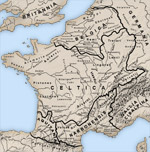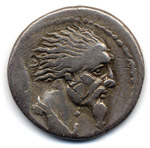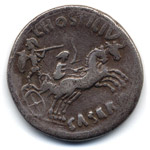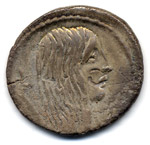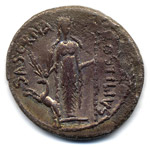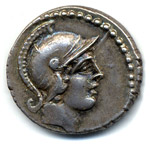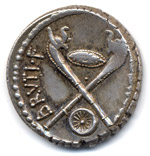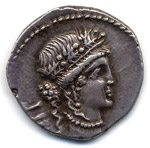The Gallic Wars (58-51BC)

The Dying Gaul
RRC 448/2
Obverse: Bearded male bust right, draped; behind, Gallic shield. Border of dots.
Reverse: Biga right, driven by charioteer holding
whip in left hand and reins in right hand; behind, on biga, warrior
facing backwards and holding shield in left hand and hurling spear
with right hand; above L·HOSTILIVS; below, SASERN. Border of dots.
RRC 448/3
Obverse: Female head right, with long hair; behind carnyx.
Border of dots.
Reverse: Artemis facing, holding spear in left hand
and placing right hand on head of stag; on right, L·HOSTILIVS downwards;
on left, SASERNA upwards. Border of dots.
Caesar's Gallic Wars contain several references to the importance of money (latin pecunia) in winning over the support of Gallic tribes. (5.55; 6.2; 7.37). The German tribes themselves often promised money to other tribes to secure support against the Romans. Caesar writes (7.64) that Vercingetorix, hoping to rouse the tribe of the Allobroges to his cause, promised their chiefs sums of money in addition to dominion over the area. It is also evident from Caesar's own account (7.55) that he used money on the campaign, but he must have been using issues struck in earlier periods rather than coins struck by his own military mint.
References to Caesar's victories in the Gallic wars only occur on coins minted after the event. The first coins (RRC 448/1-3) with a reference to his victories were struck in 48 BC, three years after the conclusion of hostilities in Gaul. It is apparent that numismatically Caesar's military successes were used to increase his reputation during the civil wars, not during his campaigns in Gaul itself.
A series of coins (RRC 448/1-3, RRC 450/1, RRC 452/1-5) celebrating Caesar's victories in Gaul appear in 48 BC. It was in this year that Caesar began hostilities against Pompey. In the previous year Pompey had released coins proclaiming his naval power (RRC 447); Caesar's coins might be seen as a response. These coins were not minted by Caesar himself, but by two of his supporters who became moneyers in this year.
The first of these was L. Hostilius Saserna (RRC 448), who released coins showing the Roman goddess Victory (RRC 448/1), and two other issues showing Gallic captives (RRC 448/2, RRC 448/3). The bearded male on the obverse of RRC 448/2 is often identified as Vercingetorix. Since this image was employed in conjunction with a female Gallic figure (RRC 448/3) a more likely interpretation is that both are generic or “typical” figures symbolising the subjugation of the Gallic tribes (Blanchet 1890). The goddess shown on the reverse of RRC 448/3 is Artemis, the chief goddess of Massalia, a city captured by Caesar in 49 BC. Her presence on the coin may be an allusion to this event.
The other moneyer, Albinus Bruti (RRC 450/1), participated in Caesar's Gallic campaigns. Mars, the god of war, is shown on the obverse of his coin, while the reverse shows two carnyces (Gallic war trumpets) in saltire (in the form of a diagonal cross or X), with shields above and below.
Caesar himself also minted coins in 48 BC advertising his military victories in Gaul; these were produced in a mint travelling with his army (RRC 452/1-5). These types continued until 44 BC, when Caesar was assassinated. An example is RRC 452/2, which on the reverse shows a trophy with a Gallic shield and carnyx, and an axe to the right. Trophies were created out of spoils taken from an enemy and were set up as a public monument. Coins (RRC 468/1-2) minted two years later, while Caesar was in Spain, also show a trophy with a male and female captive underneath.
Coins displaying images of the Gallic Wars were used to advertise and emphasise Caesar's military achievements during his war with Pompey. No coins were struck while Caesar was on campaign against the Gallic tribes.

